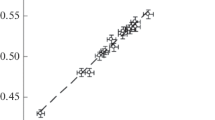Abstract
The development of a boundary layer characterised by very low gradients in temperature and salinity near the bottom boundary of a lake does not necessarily imply an increase in diapycnal mixing within the boundary layer. The results of a quasi three-dimensional diffusion model for a basin with sloping boundaries demonstrate that in lakes a boundary layer also develops when the diapycnal diffusivity is chosen to be constant.
In the model mixing is assumed to be anisotropic and is described as an isopycnal and diapycnal turbulent diffusion process. Advective transport is not considered. Therefore, the model is restricted to the description of the purely diffusive response of a lake. It should be regarded as a contribution to the discussion of boundary mixing and not as a complete mixing model for a specific lake. The isopycnal and diapycnal turbulent diffusion coefficients are presumed to be constant in space and time. The direction of isopycnal and diapycnal density flux changes with time since mixing of the density distribution influences the orientations of the isopycnals. This interaction between mixing process and density distribution is accounted for by the model.
According to the model the density distribution, and therefore the development of a boundary layer, only depends on diapycnal mixing while the distribution of a passive tracer depends on both, isopycnal and diapycnal mixing. The application of the model to the subalpine Lake Alpnach demonstrates that a simple diffusion model is sufficient to predict the development of a boundary layer. Considering that the model does not include advective processes and that diffusivities have been assumed to be constant in space and time, the structure of the boundary layer predicted agrees surprisingly well with experimental data.
Similar content being viewed by others
References
Armi, L., 1978. Some evidence for boundary mixing in the deep ocean. J. Geophys. Res. 83:1971–1979.
Carter, H. H. and A. Okubo, 1965. A study of the physical processes of the movement and dispersion in the Cape Kennedy area. Final Rep. under the U.S. Atomic Energy Comm., Cheasapeake Bay Inst., Johns Hopkins Univ., Rep. No. NYO-2973-1, pp. 164.
Chen, C.T. and F.J. Millero, 1986. Precise thermodynamic properties for natural waters covering only the limnological range. Limnol. Oceanogr. 31:657–662.
Ericksen, C. C., 1985. Implications of ocean bottom reflections for internal wave spectra and mixing. J. Phys. Oceanogr. 15:1145–1156.
Finckh, P., 1981. Heat-flow measurements in 17 perialpine lakes: Summary. Geological Society of America. Bulletin, part I, 92:108–111.
Garrett, C., 1990. The role of secondary circulation in boundary mixing. J. Geophys. Res. 95:3181–3188.
Garrett, C., P. MacCready and P. Rhines, 1993. Boundary mixing and arrested Ekman layers: rotating stratified flow near a sloping boundary. Ann. Rev. Fluid Mech. 25:291–323.
Gloor, M., A. Wüest and M. Münnich, 1994. Benthic boundary mixing and resuspension induced by internal seiches. Hydrobiologic 284:59–68.
Hindmarsh, A. C., 1980. LSODE and LSODI, two new initial value ordinary differential equation solvers. ACM-Signum Newsletter 15:10–11.
Ivey, G. N., 1987. The role of boundary mixing in the deep ocean. J. Geophys. Res. 92: 11873–11878.
Münnich, M., A. Wüest and D. M. Imboden, 1992. Observation of the second vertical mode of the internal seiche in an alpine lake. Limnol. Oceanogr. 37:1705–1719.
Pedlosky, J., 1987. Geophysical fluid dynamics. Springer Verlag, New York.
Peeters, F., A. Wüest, G. Piepke and D. M. Imboden, 1996. Horizontal mixing in lakes. J. Geophys. Res. 101:18361–18375.
Phillips O.M., 1970. On flows induced by diffusion in a stably stratified fluid. Deap-Sea Res. 17:435–443.
Powell, T. and A. Jassby, 1974. The estimation of vertical eddy diffusivities below the thermocline in lakes. Water Resour. Res. 10:191–198.
Redi, M. H., 1982. Oceanic isopycnal mixing by coordinate rotation. J. Phys. Oceanogr. 12:1154–1158.
Woods, A. W., 1991. Boundary-driven mixing. J. Fluid. Mech. 226:625–654.
Wunsch, C., 1970. On oceanic boundary mixing. Deep-Sea Research 17:293–301.
Wüest, A., G. Piepke and J. D. Halfman, 1996a. Combined effects of dissolved solids and temperature on the density stratification of Lake Malawi. In: T. D. Johnson and E. O. Odada (eds.): The Limnology, Climatology and Paleoclimatology of the East African Lakes. Gordon and Breach.
Wüest, A., D. C. Van Senden, J. Imberger, G. Piepke and M. Gloor, 1996b. Comparison of diapycnal diffusivity measured by tracer and microstructure techniques. Dyn. Atmosph. Oceans 24:27–39.
Author information
Authors and Affiliations
Rights and permissions
About this article
Cite this article
Peeters, F., Piepke, G. & Gloor, M. A diffusion model for the development of a boundary layer in lakes. Aquatic Science 59, 95–114 (1997). https://doi.org/10.1007/BF02523175
Received:
Accepted:
Issue Date:
DOI: https://doi.org/10.1007/BF02523175




